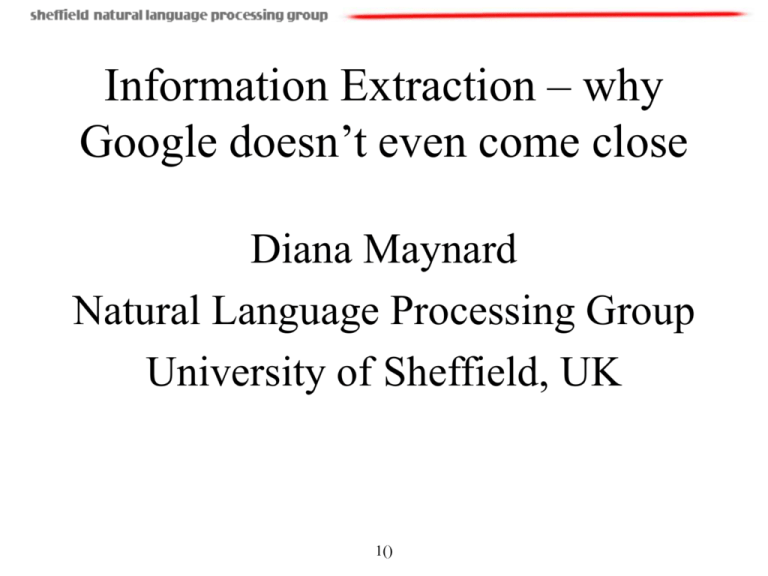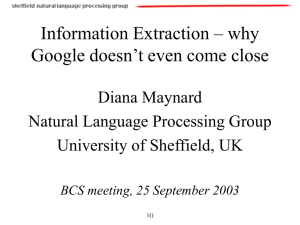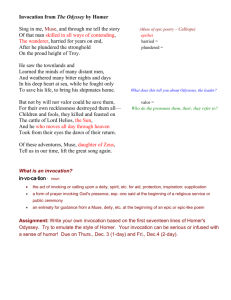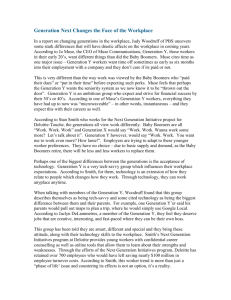Document
advertisement

Information Extraction – why
Google doesn’t even come close
Diana Maynard
Natural Language Processing Group
University of Sheffield, UK
1()
Diana Maynard
2()
Outline
• Information Extraction and Information
Retrieval
• The MUSE system for Named Entity
Recognition
• Multilingual MUSE
• Future directions
3()
IE is not IR
• IE pulls facts and structured information
from the content of large text collections
(usually corpora). You analyse the facts.
• IR pulls documents from large text
collections (usually the Web) in
response to specific keywords or
queries. You analyse the documents.
4()
IE for Document Access
• With traditional query engines, getting the facts can
be hard and slow
• Where has the Queen visited in the last year?
• Which places on the East Coast of the US
have had cases of West Nile Virus?
• Which search terms would you use to get this kind of
information?
• IE would return information in a structured way
• IR would return documents containing the relevant
information somewhere (if you were lucky)
5()
IE as an alternative to IR
• IE returns knowledge at a much deeper level
than IR
• Constructing a database through IE and linking it
back to the documents can provide a valuable
alternative search tool.
• Even if results are not always accurate, they can
be valuable if linked back to the original text
6()
When would you use IE?
• For access to news
• identify major relations and event types
(e.g. within foreign affairs or business
news)
• For access to scientific reports
• identify principal relations of a scientific
subfield (e.g. pharmacology, genomics)
7()
Application 1 – HaSIE
• Aims to find out how companies report about
health and safety information
• Answers questions such as:
“how many members of staff died or had
accidents in the last year?”
“is there anyone responsible for health and
safety”
“what measures have been put in place to
improve health and safety in the workplace?”
8()
HASIE
• Identification of such information is too timeconsuming and arduous to be done manually
• IR systems can’t cope with this because they
return whole documents, which could be
hundreds of pages
• System identifies relevant sections of each
document, pulls out sentences about health and
safety issues, and populates a database with
relevant information
9()
Application 2: KIM
Ontotext’s KIM query and results
10()
Application 3: Threat tracker
11()
What is Named Entity
Recognition?
• Identification of proper names in texts, and
their classification into a set of predefined
categories of interest
• Persons
• Organisations (companies, government
organisations, committees, etc)
• Locations (cities, countries, rivers, etc)
• Date and time expressions
• Various other types as appropriate
12()
Why is NE important
• NE provides a foundation from which to build
more complex IE systems
• Relations between NEs can provide tracking,
ontological information and scenario building
• Tracking (co-reference) “Dr Head, John, he”
• Ontologies “Manchester, CT”
• Scenario “Dr Head became the new director of
Shiny Rockets Corp”
13()
Two kinds of approaches
Knowledge Engineering
Learning Systems
• rule based
• developed by experienced
language engineers
• make use of human intuition
• require only small amount of
training data
• development can be very time
consuming
• some changes may be hard to
accommodate
• use statistics or other machine
learning
• developers do not need LE
expertise
• require large amounts of
annotated training data
• some changes may require reannotation of the entire training
corpus
14()
Basic Problems in NE
• Variation of NEs – e.g. John Smith, Mr
Smith, John.
• Ambiguity of NE types: John Smith
(company vs. person)
– June (person vs. month)
– Washington (person vs. location)
– 1945 (date vs. time)
• Ambiguity between common words and
proper nouns, e.g. “may”
15()
More complex problems in NE
• Issues of style, structure, domain, genre
etc.
• Punctuation, spelling, spacing, formatting
Dept. of Computing and Maths
Manchester Metropolitan University
Manchester
United Kingdom
> Tell me more about Leonardo
> Da Vinci
16()
List lookup approach - baseline
• System that recognises only entities
stored in its lists (gazetteers).
• Advantages - Simple, fast, language
independent, easy to retarget (just create
lists)
• Disadvantages - collection and
maintenance of lists, cannot deal with
name variants, cannot resolve ambiguity
17()
Shallow Parsing Approach
(internal structure)
• Internal evidence – names often have internal
structure. These components can be either
stored or guessed, e.g. location:
Cap. Word + {City, Forest, Center, River}
e.g. Sherwood Forest
Cap. Word + {Street, Boulevard, Avenue,
Crescent, Road}
e.g. Portobello Street
18()
Problems with the shallow parsing
approach
• Ambiguously capitalised words (first word in
sentence)
[All American Bank] vs. All [State Police]
• Semantic ambiguity
"John F. Kennedy" = airport (location)
"Philip Morris" = organisation
• Structural ambiguity
[Cable and Wireless] vs.
[Microsoft] and [Dell]
[Center for Computational Linguistics] vs.
message from [City Hospital]
19()for [John Smith]
Shallow Parsing Approach with
Context
• Use of context-based patterns is helpful in
ambiguous cases
• "David Walton" and "Goldman Sachs" are
indistinguishable
• But with the phrase "David Walton of
Goldman Sachs" and the Person entity
"David Walton" recognised, we can use
the pattern "[Person] of [Organization]" to
identify "Goldman Sachs“ correctly.
20()
Identification of Contextual
Information (1)
• Use KWIC index and concordancer to find
windows of context around entities
• Search for repeated contextual patterns of
either strings, other entities, or both
• Manually post-edit list of patterns, and
incorporate useful patterns into new rules
• Repeat with new entities
21()
Examples of semantic patterns
•
•
•
•
•
•
•
•
•
•
•
•
•
•
•
[PERSON] earns [MONEY]
[PERSON] joined [ORGANIZATION]
[PERSON] left [ORGANIZATION]
[PERSON] joined [ORGANIZATION] as [JOBTITLE]
[ORGANIZATION]'s [JOBTITLE] [PERSON]
[ORGANIZATION] [JOBTITLE] [PERSON]
the [ORGANIZATION] [JOBTITLE]
part of the [ORGANIZATION]
[ORGANIZATION] headquarters in [LOCATION]
price of [ORGANIZATION]
sale of [ORGANIZATION]
investors in [ORGANIZATION]
[ORGANIZATION] is worth [MONEY]
[JOBTITLE] [PERSON]
[PERSON], [JOBTITLE]
22()
Contextual Patterns (2)
• Automatic collection of context words with particular
features
• Collect e.g. all verbs preceding a Person annotation
(from training data)
• Sort verb list by frequency and use cut off threshold
(optional)
• Verbs can then be used to search for new Persons
• Repeat procedure with newly identified Persons
23()
MUSE – MUlti-Source Entity
Recognition
• An IE system developed within GATE
• Performs NE and coreference on
different text types and genres
• Uses knowledge engineering approach
with hand-crafted rules
• Performance rivals that of machine
learning methods
• Easily adaptable
24()
MUSE Modules
•
•
•
•
•
•
•
•
Document format and genre analysis
Tokenisation
Sentence splitting
POS tagging
Gazetteer lookup
Semantic grammar
Orthographic coreference
Nominal and pronominal coreference
25()
Switching Controller
• Rather than have a fixed chain of processing
resources, choices can be made
automatically about which modules to use
• Texts are analysed for certain identifying
features which are used to trigger different
modules
• For example, texts with no case information
may need different POS tagger or gazetteer
lists
• Not all modules are language-dependent, so
some can be reused directly
26()
Multilingual MUSE
• MUSE has been adapted to deal with
different languages
• Currently systems for English, French,
German, Romanian, Bulgarian, Russian,
Cebuano, Hindi, Chinese, Arabic
• Separation of language-dependent and
language-independent modules and submodules
• Annotation projection experiments
27()
IE in Surprise Languages
• Adaptation to an unknown language in a very
short timespan
• Cebuano:
– Latin script, capitalisation, words are spaced
– Few resources and little work already done
– Medium difficulty
• Hindi:
– Non-Latin script, different encodings used, no
capitalisation, words are spaced
– Many resources available
– Medium difficulty
28()
What does multilingual NE
require?
• Extensive support for non-Latin scripts and text
encodings, including conversion utilities
– Automatic recognition of encoding
– Occupied up to 2/3 of the TIDES Hindi effort
• Bilingual dictionaries
• Annotated corpus for evaluation
• Internet resources for gazetteer list collection
(e.g., phone books, yellow pages, bi-lingual
pages)
29()
Editing Multilingual Data
GATE Unicode Kit (GUK)
Complements Java’s facilities
• Support for defining
Input Methods (IMs)
• currently 30 IMs
for 17 languages
• Pluggable in other
applications (e.g.
JEdit)
30()
Processing Multilingual Data
All processing, visualisation and editing tools use GUK
31()
State of the art in IE research
• ML methods and robust IE systems mean
high quality results can be achieved fast
• Fast adaptation to new languages is the
focus of much current work – especially
languages such as Arabic, Chinese,
Japanese…
• So what does the future hold for IE?
32()
The future of IE
• Tools for semantic web
• Hierarchical NE recognition
• Need for IE in bioinformatics and medicine
is becoming increasingly evident
• Cross fertilisation of IE and IR , eg. For
Question Answering
• Collaboration between fields of IE and
computational terminology
33()
Thanks to Diana Maynard
34()





